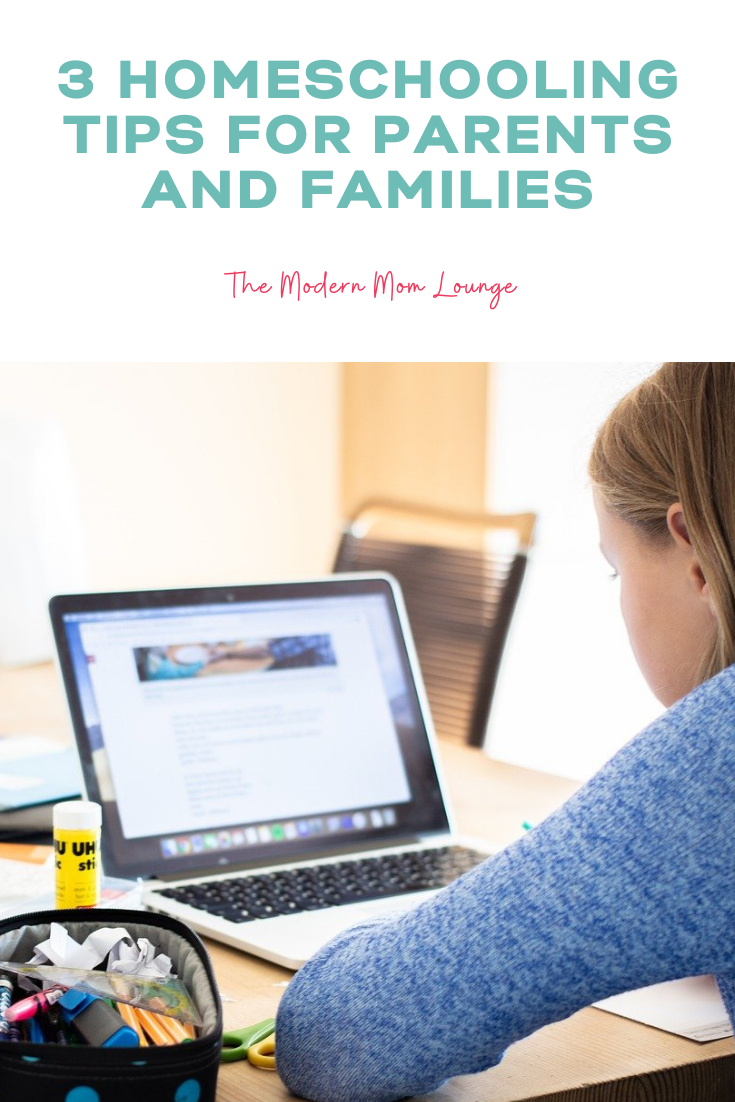3 Homeschooling Tips for Parents and Families


The global pandemic has been a disaster of epic proportions and no corner of the world has been unaffected. Restrictions have made it impossible to do most of the things we normally would including going to work, school, and visiting family and friends.
The genuine and reasonable fear of having the Covid-19 virus spread between children has meant that many schools and learning centers have been closed for quite some time, meaning many children have been left without education for a long period.
While online learning has been an option for some parents, not every family has access to the internet and/or a suitable device on which to access it. This has meant that many parents have chosen to homeschool their kids and while schools might be in the process of reopening, many parents are expected to stick to the home school plan.
Homeschooling isn’t easy though and some parents struggle with the extra work, pressure, lesson plans and even explaining the work itself. Luckily, there are some things you can do to make it a little easier on yourself:
- Use online resources
- Share the responsibility
- Make it fun
The internet is a treasure trove of resources of almost anything and is full of like-minded people willing to help while the responsibility of homeschooling can be divided between parents or even close family members who might be able to help out and planning a schedule is vital for effective lessons and one of the best advantages you have when homeschooling is that you can make it as fun as you want it to be
The Internet is Your Friend
One of the greatest things about the internet is that it provides many solutions to a multitude of problems. While it is mostly used for watching funny videos or playing games, it is essentially all the knowledge of the world in one place and you will be hard-pushed to find a subject that isn’t covered on a website somewhere.
As such, there are many online resources for homeschooling and teaching that have been created either by professional organizations, like-minded individuals, or other parents running blogs or contributing to them. Understandably, you may not have internet access at home, but public spaces such as libraries usually provide internet access either for a very small fee or completely free. Additionally, you could use the Wi-Fi access of a local coffee shop, cafe, or bar if they are open to the public.
The nature of education means that it is always changing and with each generation, it seems to have changed drastically. One of the most difficult subjects for parents who homeschool their children is mathematics. It could be that you have forgotten everything you learned when you were at school yourself or that you are one of the estimated 10% of people with dyscalculia, the math equivalent of dyslexia.
Fractions, for example, can pose quite the challenge, but online resources such as a fraction calculator can be a Godsend when it comes to checking your children’s math work. While it’s OK for you to use these resources to check work, try not to let the kids use them as they should be working these out for themselves and showing how they did it.
Other online resources are available such as lesson planning focused on the traditional K-12 education system used by most schools from kindergarten to 12th grade but how you approach homeschooling can make a huge difference on how much you enjoy it and just making the kids sit down, study, and then regurgitate facts isn’t an effective method of learning.
There are multiple teaching disciplines that have been developed, dating back to the early 1900s, and each of them assigns a different approach to teaching. The Thomas Jefferson model, for example, teaches critical thinking on a subject rather than what to think about it while the Interest-Led model allows the student to develop their own learning curriculum emphasized by their own interests such as focusing on music or literature.
A Family Affair
While many parents feel that homeschooling eventually feels less stressful than sending the children to an educational establishment, it can be very daunting at first while you try to find your rhythm, plan, and curriculum. As with most things in life, one of the best things you can do to relieve some of the pressure is to share the responsibility.
The general rule of homeschooling is to teach for around 1 to 6 hours per day which can seem like a long time when you consider all of the other responsibilities of life that you might have. Depending on what needs to be done this could be more or less, but nonetheless, it is a fair chunk of your average day.
Considering that many homeschoolers may also be employed full-time, or even part-time, effective time management due to availability can quickly become an issue. One of the easiest solutions to this is to share the responsibility of homeschooling between household members or even a private tutor for any times that no one is available.
The flexible nature of homeschooling affords you the opportunity to start school later than usual, or perhaps earlier with times that fit around your daily life or job, but sometimes even this isn’t enough as you face other responsibilities.
Spouses, partners, and older siblings can all get in on the homeschooling fun by taking the time to school children. This also makes it fun for the kids as they might become a little bored by having the same teacher all of the time and homeschooled children develop better bonds with family members since they are with them for longer periods of time than they usually would be.
Many psychologists have studied the effects of homeschooling on children, parents, and families as a whole and have conclusively stated that socialization and normalization of homeschooling help to develop stronger lifetime bonds between family members that extend to aunts, uncles, and grandparents, all of whom can help with homeschooling.
This kind of familial inclusion is something that is impossible with traditional schooling and only serves to bring the family closer together. One particular study suggests that families that choose to homeschool are ideologically opposed to societal socialization and aim to isolate their children from the wider community. Well, that’s one opinion with no actual evidence while every other study found that homeschooled children perform the same or better when it comes to civic duties and are strong members of the community, as are their families.
Teach, Engage and Learn
Apart from teaching your children in the style that you want and agree with, one of the greatest advantages of homeschooling is the ability to make it entertaining and fun. Learning at home can be engaging and entertaining since you aren’t constrained to the limitations of a classroom which can include rigid structure, overcrowding, and underfunding.
Not to disparage the amazing work that most educators do, but through no fault of their own, they may not be able to engage students as much as they would like to which can lead to negative feelings for kids in school. A recent survey performed by The Journal of Learning and Instruction found that almost 50% of children felt bored while at school and other negative emotions including stress and depression.
As a homeschooler, you have a golden opportunity to make educating your children as fun as possible by utilizing more engaging methods. Some fun activities include watching educational animation videos, being more hands-on, and incorporating toys, music, and games into learning.
Because you can engage more when homeschooling, you can form a deeper connection with your children when learning rather than forcing vapid and emotionless facts upon them resulting in an educational disconnect that makes learning boring for both yourself and the kids.
Fun and engaging learning has been shown to significantly increase the effectiveness of education. Bloom’s taxonomy of learning, for example, shows that a deeper level of understanding can be gained when approaching a subject through active learning rather than surface-based when reading books or passive learning through being read to or watching educational videos in documentary format.
Active learning could include discussing a subject openly between the group or with each other so that a better understanding can be gained, getting the children to write about what they learned and what they think of it, or creative expression of their understanding of a given subject through the medium of art, music or literature.
Ways to incorporate these could include such things as letting your children pick the subject so that they feel more included in the decision-making process and are learning about something that they are actually interested in rather than being told what to do. While fun activities are a great way of teaching and the kids love it, this shouldn’t be done all of the time since they still need to learn other subjects. A great way of doing this is to maybe set aside a particular day such as a Friday at the end of the week to allow the kids to take over. They will love this and look forward to it.






